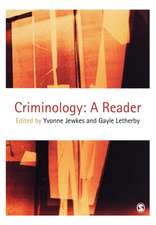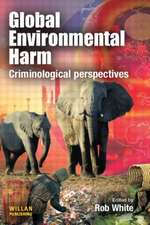Crime Types and Criminals
Autor Frank E. Haganen Limba Engleză Paperback – 22 mar 2009
Preț: 568.51 lei
Preț vechi: 668.84 lei
-15% Nou
108.78€ • 113.58$ • 90.03£
Carte tipărită la comandă
Livrare economică 05-19 aprilie
Specificații
ISBN-10: 1412964792
Pagini: 480
Ilustrații: Illustrations
Dimensiuni: 187 x 232 x 23 mm
Greutate: 0.77 kg
Ediția:1
Editura: SAGE Publications
Colecția Sage Publications, Inc
Locul publicării:Thousand Oaks, United States
Cuprins
Criminology
Fads and Fashions in Crime
The Emergence of Criminology
Crime and Deviance
Sumner's Types of Norms
Mala in Se and Mala Prohibita
Social Change and the Emergence of Law
Consensus vs. Conflict Model of Law
Crime and Criminal Law
Who Defines Crime? Criminological Definitions of Crime
The Crime Problem
The Cost of Crime
Summary
Key Concepts
Review Questions
CHAPTER 2. General Characteristics of Crime and Criminals
Caution in Interpreting Crime Data
International Variations in Crime
The Prevalence of Crime
Trends in Crime
Age and Crime
Gender Differences in Criminality
Social Class and Crime
Race and Crime
Regional Variation in Crime
Urban/Rural Differences
Institutions and Crime
The Family and Crime
Education and Crime
Religion and Crime
War and Crime
Economy and Crime
Mass Media and Crime
Criminal Typologies
A Critique of Typologies
A Defense of Typologies
Criminal Behavior Systems
Theoretical Range and Criminological Explanation
Summary
Key Concepts
Review Questions
CHAPTER 3. An Overview of Theory in Criminology
Theory
Major Theoretical Approaches
Demonological Theory
Classical and Neo-Classical Theory
Ecological Theory
Forerunners of Modern Criminological Thought
Economic Theory
Biological Theory
Psychological Theory
Mainstream Sociological Theory
Critical Sociological Theory
Integrated Theories of Crime
Summary
Key Concepts
Review Questions
CHAPTER 4. Violent Crime
History of Violence in the United States
Murder and Mayhem
Types of Murders: Multicide
Victim Precipitation
Typology of Violent Offenders
Legal Aspects
Homicide and Assault Statistics
Patterns and Trends in Violent Crime
Workplace Violence
School Violence
Guns
Sexual Assault
Acquaintance Rape
Amir vs. Brownmiller
Rape as a Violent Act
Sexual Harassment
Robbery
Conklin's Typology of Robbers
Domestic Violence
Child Abuse
Spouse Abuse
Elder Abuse
Kidnapping
Criminal Careers of Violent Offenders
Culture of Violence
Subculture of Violence
Career Criminals/Violent Predators
Societal Reaction
Summary
Key Concepts
Review Questions
CHAPTER 5. Property Crime: Occasional, Conventional and Professional
Introduction
Occasional Property Crimes
Shoplifting
Vandalism
Motor Vehicle Theft
Check Forgery
Conventional Property Crimes
Burglary
Fencing Operations
Stings
Larceny/Theft
Arson -- A Special-Category Offense
Criminal Careers of Occasional and Conventional Property Criminals
Societal Reaction
Professional Crime
The Concept of "Professional Crime"
Characteristics of Professional Crime
Argot
A Model of Professional Crime
Edelhertz's Typology
Scams
Big Cons
Maurer's The Big Con
Identity Theft
Ponzi Schemes
Pyramid Schemes
Religious Cons
Boosters
Cannons
Professional Burglars
The Box Man
The Professional Fence
Paper Hangers
Professional Robbers
Professional Arsonists
Professional Auto Theft Rings
Professional Killers
Criminal Careers of Professionals
Societal Reaction
Summary
Key Concepts
Review Questions
CHAPTER 6. White Collar Crime: Occupational and Corporate
White Collar Crime -- The Classic Statement
Related Concepts
The Measurement and Cost of Occupational and Corporate Crime
The History of Corporate, Organizational, and Occupational Crime
Legal Regulation
Occupations and the Law
Organizations and the Law
Occupational Crime
Crimes by Employees
Crimes by Employees Against Individuals (the Public)
Crimes by Employees Against Employees
Crimes by Employees Against Organizations
Crimes by Individuals (or Members of Occupations)
Corporate Crime
Crimes by Organizations/Corporations Against Individuals (the Public)
Crimes by Organizations Against Employees
Crimes by Organizations (Corporations) Against Organizations
Criminal Careers of Occupational and Organizational Offenders
Societal Reaction
Why the Leniency in Punishment?
Summary
Key Concepts
Review Questions
CHAPTER 7. Political Crime and Terrorism
Ideology
Political Crime: A Definition
Legal Aspects
The Nuremburg Principle
The Universal Declaration of Human Rights
International Law
Crimes by Government
Secret Police
Human Rights Violations
Genocide
Crimes by Police
Illegal Surveillance, Disruption, and Experiments
Scandal
Crimes Against Government
Protest and Dissent
Assassination
Espionage
Political "Whistleblowing"
Terrorism
The Oklahoma City Bombing
Criminal Careers of Political Criminals
The Doctrine of Raison d'État
Terrorism and Social Policy
Societal Reaction
Summary
Key Concepts
Review Questions
CHAPTER 8. Organized Crime
Organized Crime: A Problematic Definition
Sources of Information on Organized Crime
Types of Organized Crime (Generic Definitions)
The Organized Crime Continuum
Street Gangs
International Organized Crime
Yakuza
Chinese Triad Societies
Russian Organized Crime
The Nature of Organized Crime
Ethnicity and Organized Crime
Money Laundering
Drug Trafficking
Colombian Cartels
The Underground Empire
Theories of the Nature of Syndicate Crime in the United States
The Cosa Nostra Theory (The Cressey Model)
The Patron Theory (The Albini Model)
The Italian-American Syndicate (LAS)
The Classic Pattern of Organized Crime
Strategic and Tactical Crimes
Illegal Businesses and Activities
Big Business and Government
A Brief History of Organized Crime in the United States
Before 1930
The Luciano Period
The Genovese Period
The Appalachian Meetings
The Gambino Period
The Commission Trials
Other Developments
Criminal Careers of Organized Criminals
Public and Legal Reaction
Drug Control Strategies
Investigative Procedures
Laws and Organized Crime
Summary
Key Concepts
Review Questions
CHAPTER 9. Public Order Crime
Introduction
Nuts, Guts, Sluts, and "Preverts"
Broken Windows
Prostitution
Types of Prostitution
Massage Parlors
Johns
Underaged Prostitutes
Homosexual Behavior
Sexual Offenses
Paraphilia
Nonvictimless Sexual Offenses
Sexual Predators
Characteristics of Sex Offenders
Drug Abuse
Drugs and History
Drug Use in the United States: The Drug Dip?
Drug Abuse and Crime
Drunkenness
The Prohibition Experiment
Special Populations
Societal Reaction
Overcriminalization
Decriminalization
Summary
Key Concepts
Review Questions
CHAPTER 10. Computer Crime and the Future of Crime
Computer Crime
Types of Computer Crime
Argot of Computer Crime
Online Predators
Cyberterrorism
The Future of Crime
Predicting the Future of Crime: Methods
Other Crime Predictions
Crimewarps
The Future of Digital Crime
Other Predictions
British Home Office Predictions
Summary
Key Concepts
Review Questions
Notă biografică
Frank E. Hagan is a native of the North Side of Pittsburgh and has earned degrees at Gannon, Maryland, and Case Western Reserve. He is Professor Emeritus and the former director of the James V. Kinnane Graduate Program in Administration of Justice and is the author of eight books. These are Deviance and the Family (with Marvin B. Sussman), Introduction to Criminology (11th edition), Crime Types and Criminals, Research Methods in Criminal Justice and Criminology (10th edition), Essentials of Research Methods in Criminal Justice(3rd edition, Political Crime, White Collar Deviance (with David Simon), and The Language of Research (with Pamela Tontodonato).
He is also the author or coauthor of many journal articles and articles in edited volumes. A recipient of the Academy of Criminal Justice Sciences Fellow Award (2000), he was also awarded the Teacher¿s Excellence Award by Mercyhurst University in 2006. His major interests are research methods, criminology and organized crime, white-collar crime, and political crime and terrorism.












